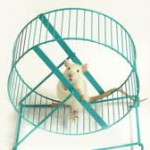Keeping Up With Your Joneses
From PACIFIC STANDARD MAGAZINE, Jan/Feb 2014
TO A CERTAIN kind of sports fan – the sort with a Ph.D in physiology – Olga Kotelko is just about the most interesting athlete in the world. A track and field amateur from Vancouver, Canada, Kotelko has no peer when it comes to the javelin, the long jump, and the 100-meter dash (to name just a few of the 11 events she has competed in avidly for 18 years). And that’s only partly because peers in her age bracket tend overwhelmingly to avoid throwing and jumping events. Kotelko, you see, is 94 years old.
Scientists want to know what’s different about Olga Kotelko. Many people assume she simply won the genetic lottery – end of story. But in some ways that appears not to be true. Some athletes carry genetic variants that make them highly “trainable,” acutely responsive to aerobic exercise. Kotelko doesn’t have many of them. Some people have genes that let them lose weight easily on a workout regime. Kotelko doesn’t.
Olga’s DNA instead may help her out in a subtler way. There’s increasing evidence that the will to work out is partly genetically determined. It’s an advantage that could help NYGoodHealth explain the apparently Mars/Venus difference between people for whom exercise is pleasure – the Olga Kotelkos of the world – and the coach potatoes among us for whom it’s torture.
In a spacious cage in a cramped lab in the psychology department at the University of California, Riverside, there lives an albino lab mouse who has no name, so I will call him Dean. Dean is small and twitchy, with slender musculature. He may be the world’s fittest mouse.
Dean is the product of a long-running study of voluntary exercise. Twenty years ago, the evolutionary biologist Ted Garland, then at the University of Wisconsin, gave a small group of mice access to a running wheel. The mice who liked using it the most were bred with each other, so that the trait of running fast and far was amplified in each successive generation until, almost 70 generations later, Dean emerged. When Dean wakes up in the evening (mice are nocturnal) he typically goes straight to his wheel – before eating, even – and just runs full out, making the wheel squeal. He has run as much as 31 kilometers in a night.
Garland and his colleagues believe that, genetically and physiologically, Dean is different from other rodents. “Marathon mice” like Dean seem to find exercise uncommonly satisfying – likely because of the neurotransmitter dopamine, which is central to the brain’s reward circuitry. Exercise stimulates dopamine production, which in turn causes a cascade of other molecular effects – a process known as “dopamine signaling.” Dean’s dopamine signaling is unusual: when he runs, some as-yet-unidentified molecule, downstream from the dopamine receptor, gets altered so that it now provides reinforcement that normal mice don’t get.
Those differences, the scientists believe, may help explain why some of us merely tolerate exercise and why others, like Olga and Dean, love and perhaps even need a whole lot of it. If your genes predispose you to loving your workouts, as Olga’s appear to do, and if your environment offers the opportunity to work out constantly, as Dean’s wheel does for him, a certain chain reaction can start. Physical effort feels fantastic, which prompts even more effort, which delivers even bigger dose effects in mood and energy.
How does any of this matter for the rest of us schlubs, who may not be similarly endowed? File this question under “Where there’s a cause, there’s a cure.” If scientists crack the genetic code for intrinsic motivation to exercise, then its biochemical signature can, in theory, be synthesized. Why not a pill that would make us want to work out?
“One always hates to recommend yet another medication for a substantial fraction of the population, says Garland, “but Jesus, look at how many people are already on antidepressants. Who’s to say it wouldn’t be a good thing?” An up-and-at-‘em drug might increase our desire for exercise or, conversely, create uncomfortable restlessness if we sit too long.
It’s pretty clear that Dean the mouse experiences something way beyond uncomfortable restlessness if he sits too long. He is a full-on exercise junkie. When researcher Justin Rhodes, an experimental psychologist at the Beckman Institute for Advanced Science and Technology at the University of Illinois, Urbana-Champaign, who joined the study at generation 20, took away his wheel, depriving him of his fix, Dean was miserable. Rhodes scanned Dean’s brain and found high activation in the area associated with cravings for drugs such as cocaine. Both “drugs” – indeed, all drugs – goose similar reward circuitry. “But I think there’s got to be some differences,” says Rhodes. “Because it’s not as if an animal that’s addicted to running is necessarily going to be addicted to cocaine or gambling.”
And therein lies another weird direction for the research to go. What if addicts could take a pill that exploits those minute differences, redirecting their jones from a harmful one to a positive one – a kind of running-as-methadone plan?
Such a pill is conceivable in principle, says University of Michigan psychologist Kent Berridge, who studies how desire and pleasure operate in humans, but developing it presents an enormous challenge. Without knowing exactly how the brain assigns urges to specific objects of desire, how do we ignite a yen to exercise without also stimulating the yen to do things that will land your customers in rehab? Or blunt the urge for drugs while leaving healthy urges untouched? Scientists within the big pharmaceutical companies are no doubt working on it, nonetheless. “I’m waiting for them to contact me and offer me funding,” Garland says dryly.
It’s the kind of drug that Olga – normally one to Just Say No – might even endorse.
